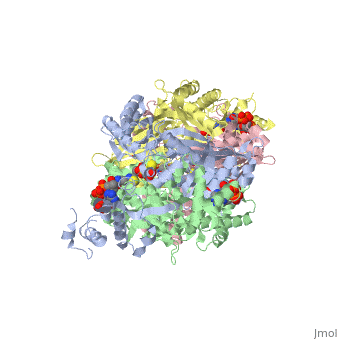Caspase-3 Regulatory Mechanisms: Difference between revisions
Scott Eron (talk | contribs) |
Scott Eron (talk | contribs) |
||
| Line 29: | Line 29: | ||
<scene name='Caspase-3_Regulatory_Mechanisms/ | <scene name='Caspase-3_Regulatory_Mechanisms/Scene2_nospin_corrected/1'>L2 and L2'</scene> | ||
Revision as of 20:18, 12 December 2012
IntroductionIntroduction
Caspases are cysteine-dependent aspartic acid proteases and are the key facilitators of apoptosis or programmed cell death. Apoptosis is tightly regulated by these caspases, and dysregulation of caspase functions have been implicated in wide variety of diseases such as neurodegeneration, cancer, heart disease and some metabolic disorders. As such, caspases are considered to be attractive drug targets to treat these disorders.
Existing as proenzymes, caspases undergo proteolytic processing at conserved aspartate residues in their intersubunit linker to produce the large and small subunit. These subunits then dimerize to form the active enzyme. Any apoptotic signal received by the cell results in sequential activation of caspases. Upstream or initator caspases (-2,-8, -9 and -10) are first activated by forming a holoenzyme wherein they associate with another protein platform or adaptor protein. Once active, initiator caspases cleave and activate the executioner caspases (-3, -6 and -7) which in turn cleave their respective protein targets initiating cell death.
Caspase-3 structure
Regulation of Caspase-3Regulation of Caspase-3
Anything in this section will appear adjacent to the 3D structure and will be scrollable.
|
| ||||||||||
Caspase-3 Active Site and Loop Bundle AnalysisCaspase-3 Active Site and Loop Bundle Analysis
Lets give it a shot.
<StructureSection load='1dq8' size='350' side='right' caption='Structure of Caspase-3 with substrate bound (PDB entry 2H5I)' scene='Caspase-3_Regulatory_Mechanisms/Scene1/1'>
GAAAAHHHHHHHH
Active site analysis
haaaa
